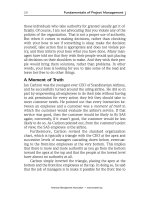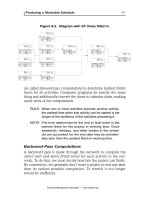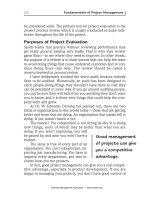IT project management 3rd by THompson chappter 02
Bạn đang xem bản rút gọn của tài liệu. Xem và tải ngay bản đầy đủ của tài liệu tại đây (173.49 KB, 29 trang )
Chapter 2:
The Project Management and
Information Technology
Context
Learning Objectives
• Understand the systems view of project management
and how it applies to information technology projects
• Analyze a formal organization using the structural,
human resources, political, and symbolic
organizational frames
• Explain the differences among functional, matrix,
and project organizational structures
• Explain why stakeholder management and top
management commitment are critical for a project’s
success
Learning Objectives
• Understand the concept, development,
implementation, and close-out phases of the
project life cycle
• Distinguish between project development and
product development
• Discuss the unique attributes and diverse nature
of information technology projects
• List the skills and attributes of a good project
manager in general and in the information
technology field
Projects Cannot Be Run
in Isolation
• Projects must operate in a broad organizational
environment
• Project managers need to take a holistic or
systems view of a project and understand how it
is situated within the larger organization
• See example in opening and closing case to
illustrate this concept
A Systems View of Project
Management
• A systems approach emerged in the 1950s to describe
a more analytical approach to management and
problem solving
• Three parts include:
– Systems philosophy: View things as systems, interacting
components working within an environment to fulfill
some purpose
– Systems analysis: problem-solving approach
– Systems management: Address business, technological,
and organizational issues before making changes to
systems
Figure 2-1. Three Sphere Model
for Systems Management
Understanding Organizations
Structural frame:
Focuses on roles and
responsibilities,
coordination and control.
Organizational charts help
define this frame.
Human resources frame:
Focuses on providing
harmony between needs of
the organization and needs
of people.
Political frame: Assumes
organizations are
coalitions composed of
varied individuals and
interest groups. Conflict
and power are key issues.
Symbolic frame: Focuses
on symbols and meanings
related to events. Culture
is important.
What Went Wrong?
Many enterprise resource planning (ERP) projects fail due to
organizational issues. For example, Sobey’s Canadian grocery store
chain abandoned its two-year, $90 million ERP system due to
organizational problems.
As Dalhousie University Associate Professor Sunny Marche states,
“The problem of building an integrated system that can
accommodate different people is a very serious challenge. You can’t
divorce technology from the sociocultural issues. They have an
equal role.” Sobey’s ERP system shut down for five days and
employees were scrambling to stock potentially empty shelves in
several stores for weeks. The system failure cost Sobey’s more than
$90 million and caused shareholders to take an 82-cent after-tax hit
per share.*
*Hoare, Eva. “Software hardships,” The Herald, Halifax, Nova Scotia (2001)
Many Organizations Focus on the
Structural Frame
• Most people understand what organizational
charts are
• Many new managers try to change
organizational structure when other changes are
needed
• 3 basic organizational structures
– functional
– project
– matrix
Basic Organizational Structures
Table 2-1. Organizational Structure
Influences on Projects
The organizational structure influences the project manager’s authority,
but project managers need to remember to address the human resources,
political, and symbolic frames, too.
Recognize the Importance of
Project Stakeholders
• Recall that project stakeholders are the people
involved in or affected by project activities
• Project managers must take time to identify,
understand, and manage relationships with all
project stakeholders
• Using the four frames of organizations can
help meet stakeholder needs and expectations
• Senior executives are very important
stakeholders
Table 2-2. What Helps Projects
Succeed?
According to the Standish Group’s report “CHAOS 2001: A
Recipe for Success,” the following items help IT projects
succeed, in order of importance:
–
–
–
–
–
–
–
–
–
Executive support
User involvement
Experienced project manager
Clear business objectives
Minimized scope
Standard software infrastructure
Firm basic requirements
Formal methodology
Reliable estimates
Need for Top Management
Commitment
• Several studies cite top management
commitment as one of the key factors associated
with project success
• Top management can help project managers
secure adequate resources, get approval for
unique project needs in a timely manner, receive
cooperation from people throughout the
organization, and learn how to be better leaders
Need for Organizational Commitment to
Information Technology (IT)
• If the organization has a negative attitude
toward IT, it will be difficult for an IT project to
succeed
• Having a Chief Information Officer (CIO) at a
high level in the organization helps IT projects
• Assigning non-IT people to IT projects also
encourages more commitment
Need for Organizational
Standards
• Standards and guidelines help project managers
be more effective
• Senior management can encourage
– the use of standard forms and software for project
management
– the development and use of guidelines for writing
project plans or providing status information
– the creation of a project management office or center
of excellence
Project Phases and the Project
Life Cycle
• A project life cycle is a collection of project
phases
• Project phases vary by project or industry, but
some general phases include
–
–
–
–
concept
development
implementation
support
Phases of the Project Life Cycle
Product Life Cycles
• Products also have life cycles
• The Systems Development Life Cycle (SDLC) is a
framework for describing the phases involved in
developing and maintaining information systems
• Systems development projects can follow
– predictive models: the scope of the project can be clearly
articulated and the schedule and cost can be predicted
– adaptive models: projects are mission driven and component
based, using time-based cycles to meet target dates
Predictive Life Cycle Models
• The waterfall model has well-defined, linear stages of
systems development and support
• The spiral model shows that software is developed using
an iterative or spiral approach rather than a linear
approach
• The incremental release model provides for progressive
development of operational software
• The prototyping model is used for developing prototypes
to clarify user requirements
• The RAD model is used to produce systems quickly
without sacrificing quality
Adaptive Life Cycle Models
• Extreme Programming (XP): Developers
program in pairs and must write the tests for
their own code. XP teams include developers,
managers, and users
• Scrum: Repetitions of iterative development are
referred to as sprints, which normally last thirty
days. Teams often meet every day for a short
meeting, called a scrum, to decide what to
accomplish that day. Works best for objectoriented technology projects and requires strong
leadership to coordinate the work
Distinguishing Project Life
Cycles and Product Life Cycles
• The project life cycle applies to all projects,
regardless of the products being produced
• Product life cycle models vary considerably
based on the nature of the product
• Most large IT systems are developed as a series
of projects
• Project management is done in all of the product
life cycle phases
Why Have Project Phases and
Management Reviews?
• A project should successfully pass through each
of the project phases in order to continue on to
the next
• Management reviews (also called phase exits or
kill points) should occur after each phase to
evaluate the project’s progress, likely success,
and continued compatibility with organizational
goals
What Went Right?
"The real improvement that I saw was in our ability toin the words
of Thomas Edisonknow when to stop beating a dead horse.…
Edison's key to success was that he failed fairly often; but as he said,
he could recognize a dead horse before it started to smell...as a result
he had 14,000 patents and was very successful…In IT we ride dead
horsesfailing projectsa long time before we give up. But what we
are seeing now is that we are able to get off them; able to reduce cost
overrun and time overrun. That's where the major impact came on
the success rate.”
Cabanis, Jeannette, "'A Major Impact': The Standish Group's Jim Johnson On
Project Management and IT Project Success," PM Network, PMI, September
1998, p. 7
The Context of IT Projects
• IT projects can be very diverse in terms of size,
complexity, products produced, application area,
and resource requirements
• IT project team members often have diverse
backgrounds and skill sets
• IT projects use diverse technologies that change
rapidly. Even within one technology area,
people must be highly specialized









